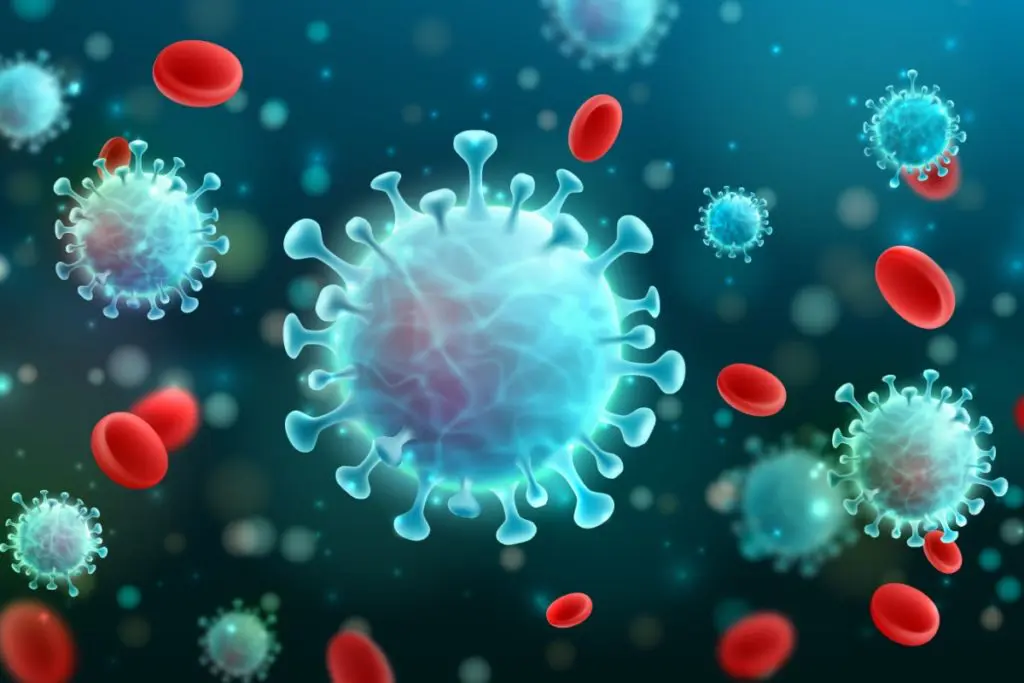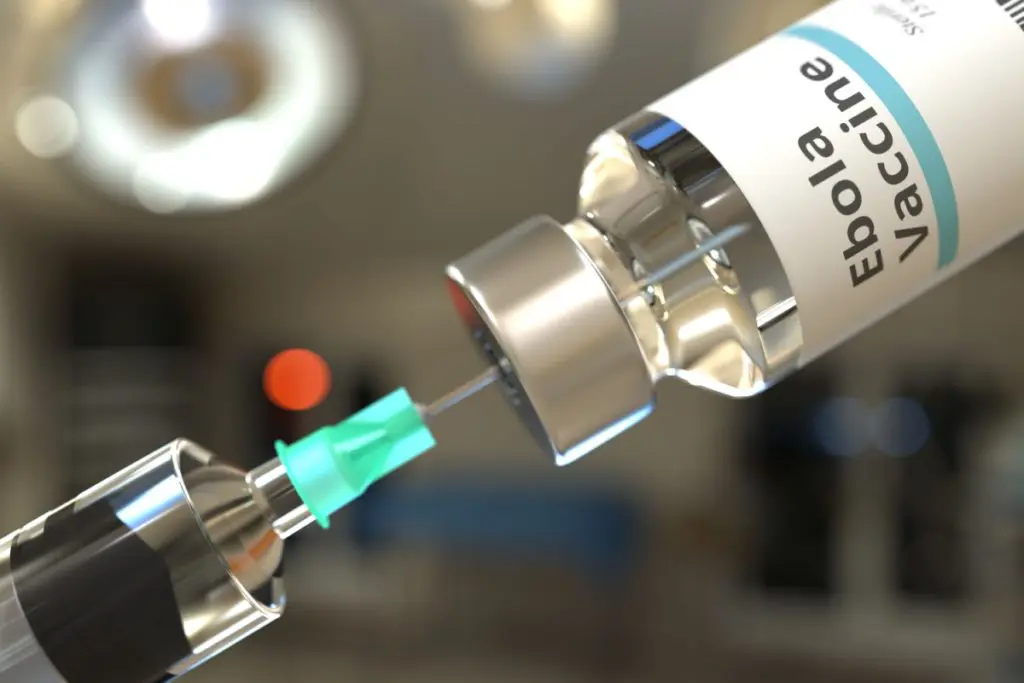The Ministry of Health of Uganda declared the end of the most recent Ebola outbreak on January 11, 2023. During the outbreak, the disease infected 164 people, killing 77 of them.
Over 15,000 people have been killed by the virus throughout several outbreaks. While not as lethal as deadlier pathogens like the plague or COVID-19, it has made its mark on the world and continues to be a looming threat.
Throughout our comprehensive look at the Ebola virus, we will answer the following questions:
- What is it exactly?
- How long has it been around?
- Are there different types?
- How do you catch it?
- What are the symptoms?
- What should you do if you have it?
- How can you prevent it?
Let’s get started.
What Is the Ebola Virus?
First, let’s look at what the Ebola virus isn’t. It’s not malaria, Typhoid fever, the flu, dengue fever, Lassa fever, yellow fever, or meningitis. It’s not a bacterial infection.

All of those diseases share similar symptoms (which we’ll discuss in a bit) to Ebola, but what makes Ebola unique is:
- Unlike malaria, a parasitic disease, or typhoid fever, a bacterial disease, Ebola is part of the viral family. Specifically, it is caused by a Filoviridae family virus in the Ebolavirus genus.
- It has a high mortality rate. Anywhere between 25% to 90% of people who contract the disease will die from it, depending on if the infected can receive medical care.
- Its incubation period is up to 21 days, making containment and outbreak management difficult. Symptoms appear suddenly, but Ebola is not contagious until those symptoms appear.
- Unlike other diseases that may affect one area of the body at a time, Ebola affects multiple organ systems simultaneously and more severely.
Simply put, Ebola is a deadly viral disease.
History of Ebola Outbreaks
There have been six major Ebola outbreaks.
1. Democratic Republic of the Congo (1976)
- Cases: 318
- Deaths: 280
- Fatality rate: 88%
The first recorded Ebola outbreak happened near the Ebola River in what is now the Democratic Republic of the Congo (DRC). Researchers, hoping to avoid damaging the reputation of the village of Yambuku, where the outbreak began, decided to name the virus after the nearby river.
Initially, doctors misdiagnosed the virus as malaria, which shared similar symptoms and was common in the region.
The misdiagnosis prevented healthcare workers from taking the necessary precautions to stop the virus from spreading. Also, the virus spread due to a lack of sterilization and containment policies.
2. Nzara, South Sudan (1976)
- Cases: 284
- Deaths: 151
- Fatality rate: 53%
The South Sudan outbreak, which occurred soon after the Ebola River outbreak, had a much lower fatality rate. That’s because the Sudan variant was weaker than the DRC variant.
Also, the Sudan outbreak happened in a more isolated area with fewer people.
3. Kikwit, DRC (1995)
- Cases: 315
- Deaths: 250
- Fatality rate: 81%
Nearly 20 years after the first outbreaks, the third major outbreak highlighted a lack of infection control measures in the area. The high fatality rate was again due to inadequate hospital sterilization and containment practices.
4. Gulu, Uganda (2000 to 2001)
- Cases: 425
- Deaths: 224
- Fatality rate: 53%
The Uganda outbreak saw a significant response from international health organizations. Rapid response teams from the World Health Organization (WHO), Centers for Disease Control and Prevention (CDC), were sent to Uganda to treat patients and contain the virus.
Proper quarantining and isolation practices were taught through health education campaigns, and the Ugandan government helped to strictly enforce these polices to prevent the spread of the virus.
5. West Africa (2014 to 2016)
- Cases: 28,616
- Deaths: 11,325
- Fatality rate: 40%
The outbreak started in a small village in Guinea where it is believed a two-year-old boy contracted the virus while playing with a fruit bat. It spread quickly to Sierra Leonne. The local hospitals were overwhelmed by the number of cases.
Again, organizations like WHO, the CDC, and others provided extensive rapid response efforts, including building treatment centers and training local healthcare workers.
However, these efforts were met with challenges due to the region’s weak healthcare infrastructure.
Misinformation and fear spread throughout the region, making it harder for medical professionals to control the spread of the virus. In fact, many frontline healthcare workers died trying to contain the virus.
Experimental vaccines were used to help control the outbreak, though they were used more extensively in later outbreaks.
6. DRC (2018 to 2020)
- Cases: 3,481
- Deaths: 2,299
- Fatality rate: 66%
It was difficult for frontline healthcare workers to contain the Ebola outbreak in the DRC in 2018. A major issue was the ongoing social unrest in the area. For instance, armed groups would frequently attack Ebola treatment centers and health workers.
Another issue was the local population’s distrust of international organizations and their own government. Misinformation about the virus made it hard to quarantine and contain those infected.
7. DRC (2021 to 2022)
- Cases: 12
- Deaths: 6
- Fatality rate: 50%
One of the most recent Ebola outbreaks was also the smallest. This may suggest an improvement in the healthcare system in the area.
The DRC government and international health organizations were able to quickly contain the outbreak, greatly reducing the spread.
Types of Ebola
As we saw with the simultaneous outbreaks in DRC and Sudan, Ebola isn’t always the same.

The main difference between the Ebola types is their severity. Here are the different types we’ve seen so far:
- Zaire: the most severe and deadly form of Ebola; it is named after a river in the DRC
- Sudan: not as deadly as Zaire, but still serious; discovered in South Sudan
- Reston: not deadly or dangerous to humans at all; found in Virginia, U.S. and the Philippines
- Tai Forest: with only one known human case, we do not know the deadliness of this type; discovered in Cote d’Ivoire
- Bundibugyo: Moderately lethal compared to Zaire or Sudan ebolaviruses; first identified in the Bundibugyo district of Uganda
Virus Transmission
Each version of the ebolavirus is transmitted in the same ways. Specifically, the virus spreads to humans during direct contact with:
- Bodily fluids from an infected person
- Contaminated objects or surfaces
- Infected animals
Human-to-human transmission mostly occurs with direct contact with infected bodily fluids.
The virus does not spread through the air or water. It also doesn’t spread through food, with the exception of bushmeat. Bushmeat is the meat of wild animals. The ones with potential carriers of Ebola include fruit bats, primates, antelopes, rodents, and porcupines.
As noted previously, Ebola patients do not become contagious until they develop symptoms. This makes it easier to contain the virus.
Symptoms of Ebola
Those infected with the ebolavirus can show symptoms two to 21 days after exposure. The symptoms may start small, but they can progress quickly. Here are the stages:
- Stage 1: Early symptoms include fever, headache, muscle pain, weakness, fatigue, and sore throat
- Stage 2: Progressive symptoms include vomiting, diarrhea, stomach pain, and rash
- Stage 3: Severe symptoms include impaired kidney and liver function, as well as internal and external bleeding
- Stage 4: Critical symptoms include shock, organ failure, and ultimately death.
As with other deadly viruses, early diagnosis and treatment can limit symptoms to the early stages and increase the chance of survival.
Diagnosis and Treatment
When a doctor checks someone for the ebolavirus, they will ask if the patient has recently traveled to an area with an outbreak or had contact with someone infected with the virus. They will also check for stage one symptoms.
Health professionals can confirm infection using blood tests.
Treatment involves supportive care and treatments, including rehydration, oxygen therapy, and medication to stabilize blood pressure and treat secondary infections.
Experimental treatments include antiviral drugs like remdesivir. There are also lab-made antibodies that can target the virus.
Prevention and Control
Hopefully, there will never be another major Ebola outbreak. We know much more about the virus, including how to slow transmission.
One of the most effective ways to prevent outbreaks is to vaccinate people living in at-risk areas. Additionally, good hygiene, sterilized healthcare equipment, and safe burial practices can go a long way toward preventing disease transmission.